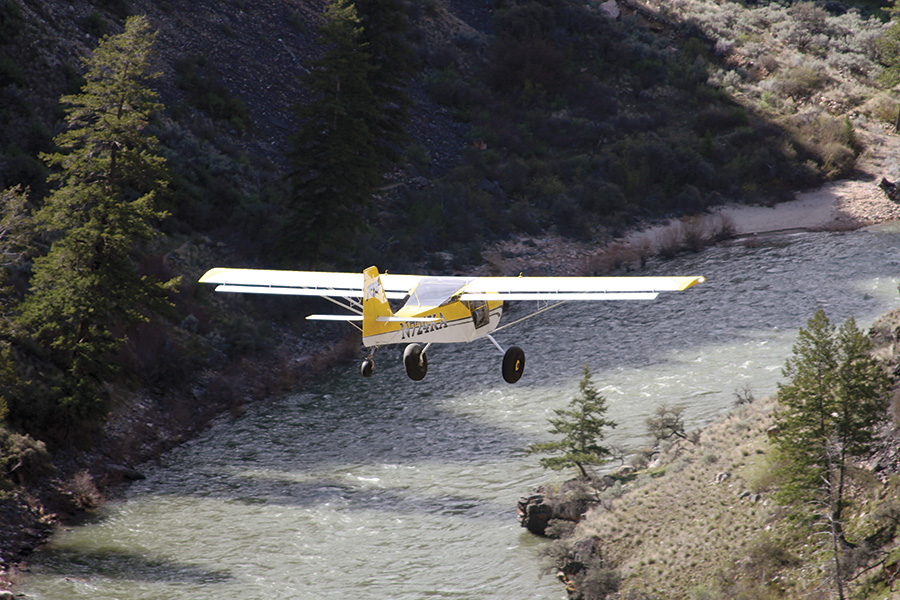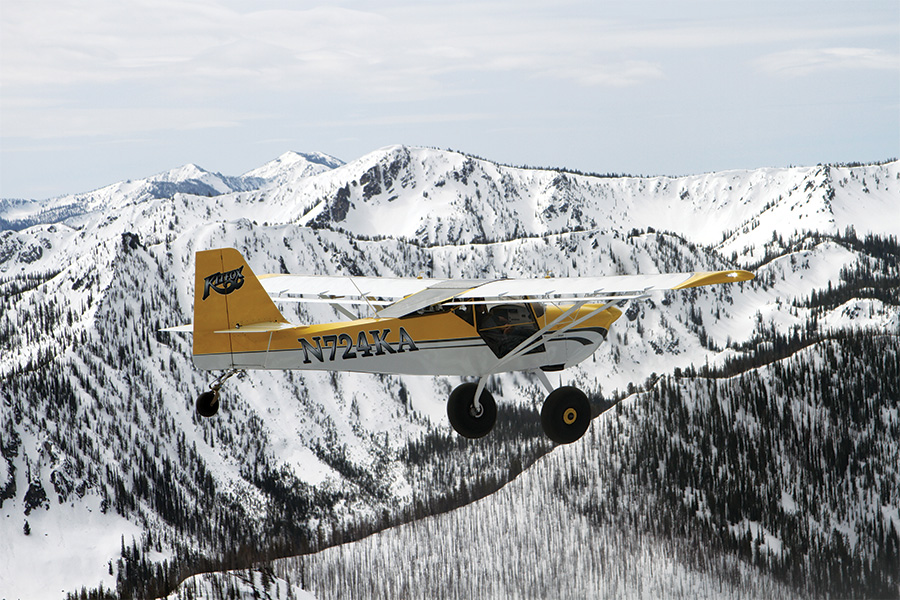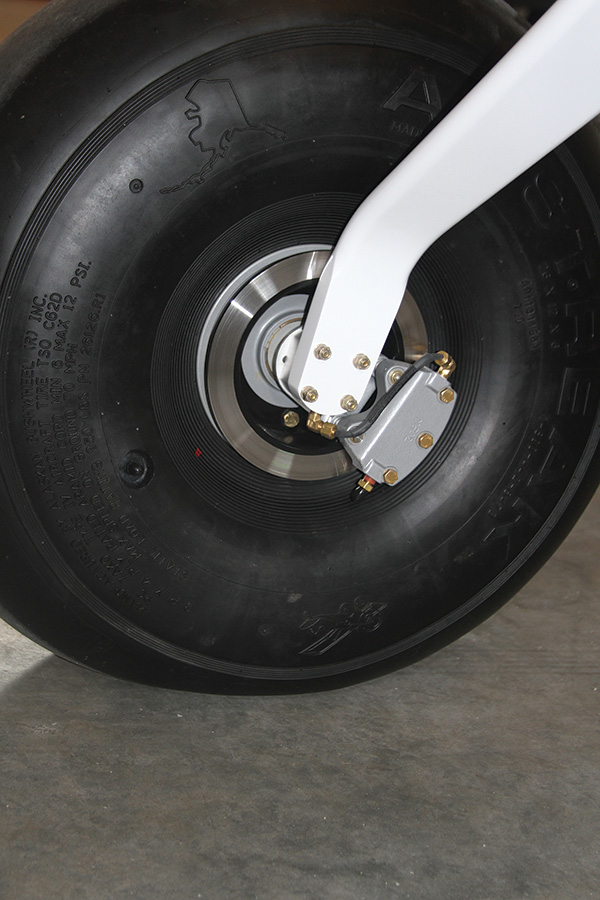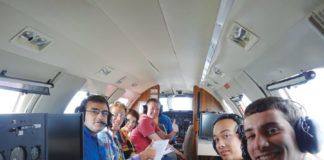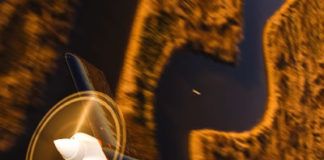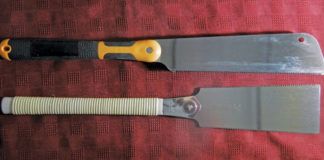“For this one, I just want to let you know, once we turn final, we are committed—no go-around—we have to make it work!” These words from instructor Paul Leadabrand in the other seat reminded me that it was definitely time to be on my game. I pulled on full flaps, trimmed off the stick forces to give myself a comfortable, yet slow approach speed, and added some power as I picked my spot.
“Those trees at the bottom of the slope are kind of high, so let’s aim about a third of the way up the runway, about by the windsock. Remember to keep lots of power in as we touch down, and then add some more so we can climb the hill!” Added reminders from Leadabrand as I concentrated on my sight picture. We were unfortunately landing straight into the morning sun—but that was going to go away behind the ridge as we got in close. Approaching over a thawing, but ice-covered mountain lake, the runway we were approaching had slope to spare—an uphill slope that would be a good climb on foot, a tough ride on a mountain bike. As we got closer, I could see that the surface would be no problem for the big bush wheels on the Kitfox Super Sport we were flying. And I also realized that the slope was steeper than we could climb. Well that made it simple—just keep in the center of the dirt, between the forest carved out on either side, and the ground would come up to meet us!
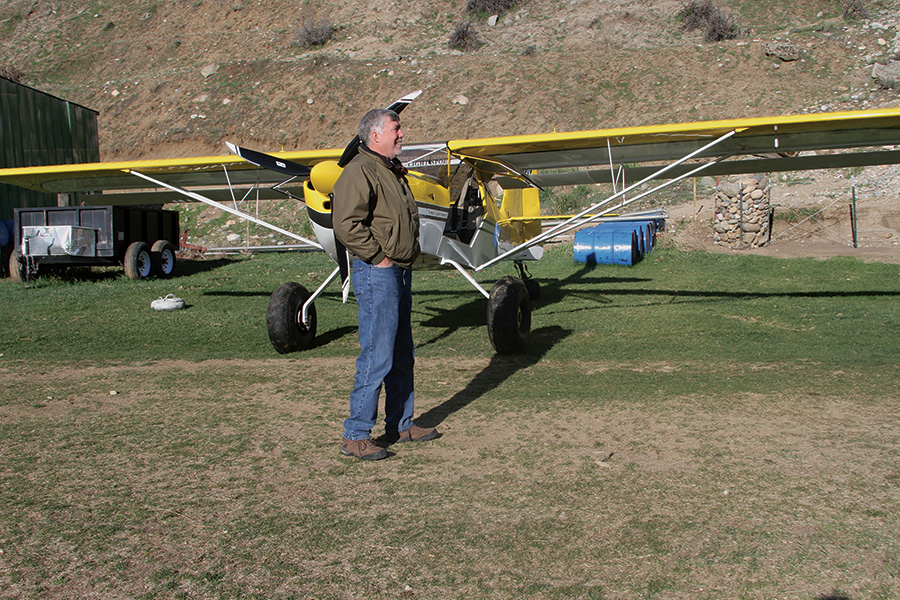
Paul Leadabrand, founder and owner of Stick & Rudder Aviation, never stops grinning around airplanes and mountains, best that we can tell.
There was little flare; we simply flew into the hill with all three wheels, and the big tires made the landing soft. Power on and we climbed the crest of the hill. There couldn’t have been more than a thousand feet of “runway,” but we only need about a hundred. Landing long would have made the climb easier, but I wasn’t ready to give away runway just yet—this was, after all, my first day in the Idaho backcountry, and only my third landing “in the wild.” No need to get cocky, even though Paul’s expert instruction, and the easy handling of the Kitfox, already had me feeling like I had done this a hundred times. The dependent flaperons keep flying at ridiculously slow airspeeds, giving a positive control feel, even when it appears you are in a hover, and I wasn’t feeling rushed as I picked my exact touchdown spot. It felt a little like the aerial equivalent of picking rocks on which to cross a stream—one foot here, the next here, and the last there…and you’re down!
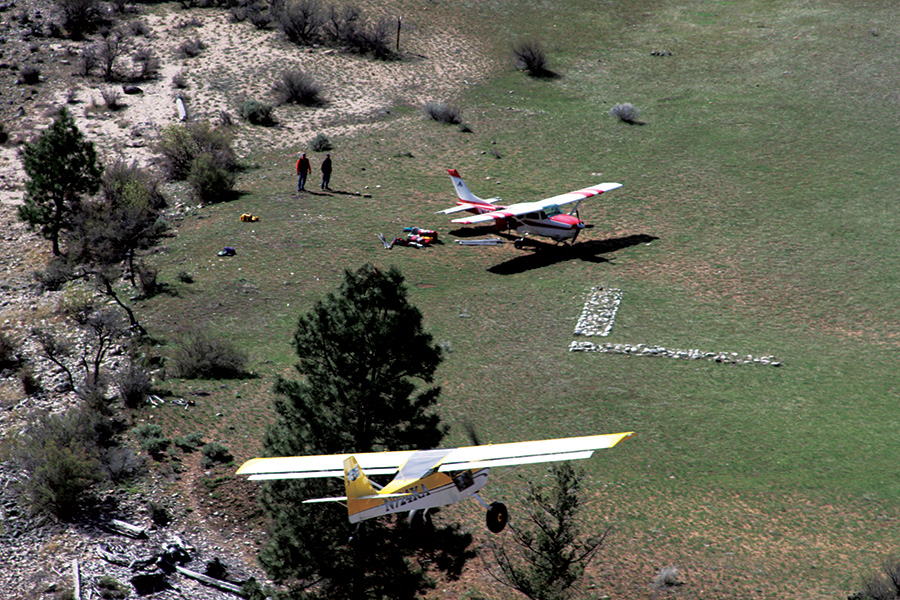
Leadabrand on very short final for a strip in the back country. Pilots learn to use all of the controls and aerodynamics of the aircraft to put the machine where they want it.
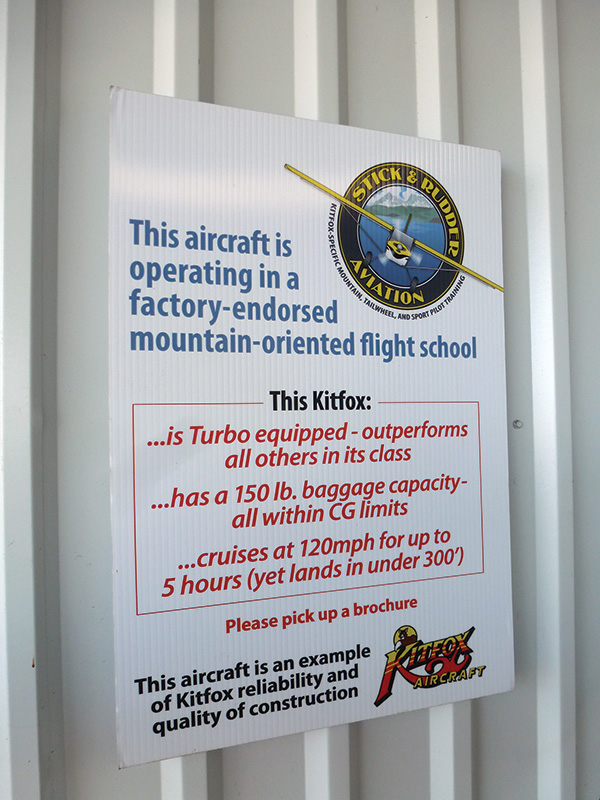
The partnership between Kitfox and Stick & Rudder is a good thing for Kitfox builders and those who want to learn to fly in the mountains.
Leadabrand, the founder and owner of Stick & Rudder Aviation of Boise, Idaho, has been flying this backcountry all of his life. He’s lived the life of a corporate pilot, a mountain freight hauler, and now specializes in training people to fly Kitfox aircraft, and to do it in the mountains. Stick & Rudder enjoys a symbiotic relationship with Kitfox Aircraft, just down the road in Homedale—part of the greater Boise area. John McBean, owner of Kitfox, is one of those kit manufacturers who believes strongly in type-specific transition training, and has worked hard to build a strong relationship with Paul, steering builders and buyers to Stick & Rudder for transition training. Together, they want to make sure that when a new pilot takes his own Kitfox out for the first time, he is ready to handle the airplane with confidence—and adding a little mountain flying to the transition mix is a great way to expand a pilot’s comfort zone quickly.
This is Not a Test
My two-day visit was but a sampler of what a new Kitfox pilot might expect when they show up at Boise Airport and meet up with Paul. Combining the training with a factory visit to see what was up at Kitfox gave us a couple of half-days to fly, and Paul wasted little time in getting started. First things first: “This is not a test. You are not here to please me. You are here to learn and have fun.” These three points he made loud and clear. A significant number of Leadabrand’s clients come from military and airline backgrounds, where training is always done under pressure to perform and succeed. His approach is anything but. His students aren’t going for ratings (in general), they are there for the experience. There aren’t any tests to pass; there is simply knowledge and skills to be absorbed. That makes for a much more relaxing experience and a realistic partnership between instructor and student. We talked about the points he usually makes in an hour or two of ground school, and I gathered that the length of the school depends greatly on the student’s experience with this type of aviation.
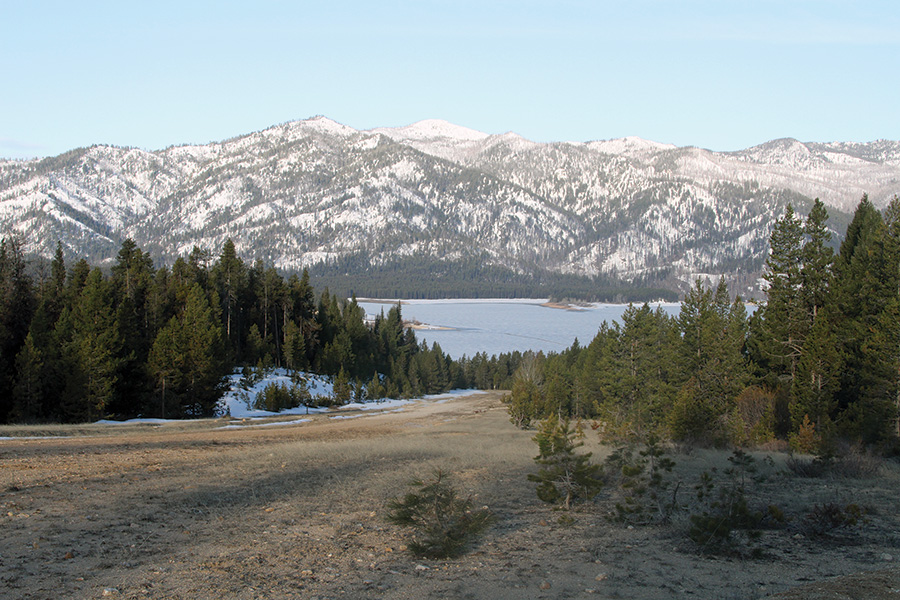
The runway at Deadwood Reservoir is little more than a widened logging road extending up from the lake. The angle between the vertical trees and the ground give an idea of the slope.
After chatting awhile, and with the clock ticking on our visit to Kitfox and a building wind, we climbed into one of his two identical Kitfox Super Sports and prepared to take off. We talked about the difference in operating Rotax engines versus the Lycomings I am more familiar with—and one of the best things I found was that they had removed the spring that drives the throttle to full open when you let go of it. I like the Rotax in general—but not this factory characteristic. Both the factory SLSA and the two owned by Stick & Rudder had only a very light spring, and it was loading the throttle toward idle. Much better in my opinion. The aircraft we flew was equipped that day with Alaskan Bushwheels—low pressure, large tires that really help you stick a landing on rough terrain. Their other aircraft was sporting 800 x 6s, but the wheels can be swapped in about 45 minutes if you wish to be flexible. The bush tires cost a few knots of drag, so some might want both so they can equip for the mission.
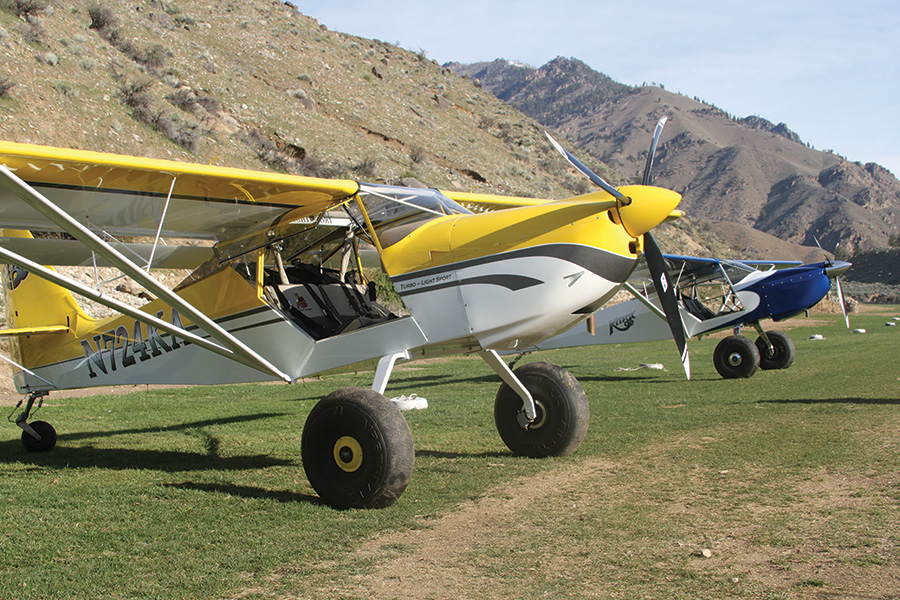
A pair of Kitfoxes rest at the Flying B Ranch airstrip, on the middle fork of the Salmon River, while their occupants feast on a ranch breakfast. Turbocharged Rotax 914s make these airplanes superb mountain aircraft.
The next two hours consisted of a lot of fun, a lot of laughing, and a lot of landings at nearby airstrips spread across the Snake River valley. This included everything from runways in good condition to runways with faded and cracked pavement. We landed on grass, and in an unimproved farm field. The Kitfox with the Bushwheels did great on all of it—although I looked at those big, soft rubber tires and cringed a bit when touching down on asphalt. Having owned a Cub for many years, I am sensitive to what wears out expensive tires!
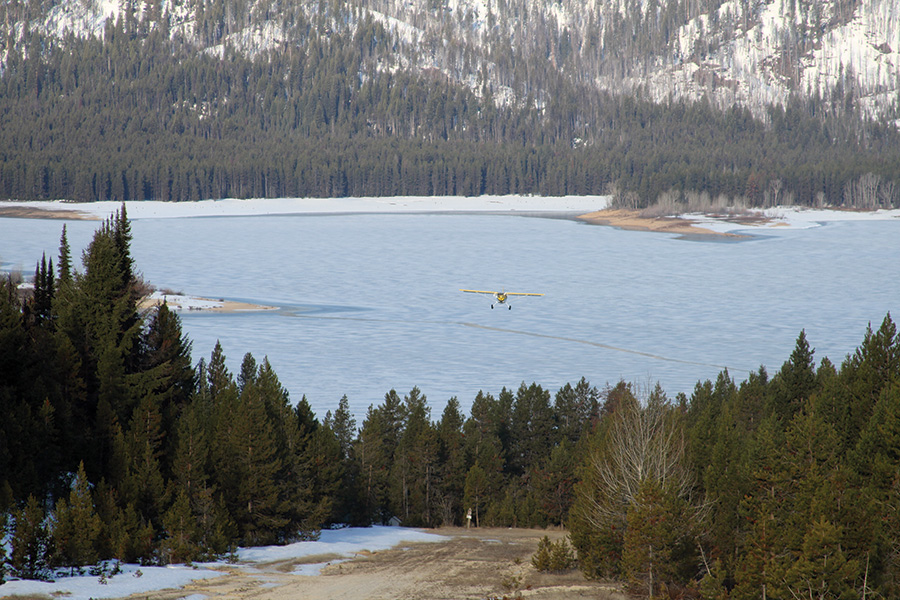
A Kitfox on approach to Deadwood Reservoir. The task is to simply fly into the hill, then keep the power in, so that you can make it to the top of the hill. Ground roll for a power-off landing is negligible.
Short-Field Specialist
The Kitfox has several unique handling qualities that make it a good short-/rough-field airplane. The aluminum gear is forgiving; the full-span flaperons are always flying, giving good control; and the bubble Plexiglas doors give the pilot an excellent view of where they are in relation to the ground for flare. The airplane flies nice and slow, with plenty of reserve lift for maneuvering close to the ground while still climbing. At one airpark, up tight against the Snake River, we lifted off and, at about 200 feet, did a tight 180 toward the river—and toward the high cliff on the opposite bank. We then did another 180, again toward the bluff, and it never felt like we were going to come close to the rocks or stall in the turn. The airplane practically pivots over a point on the ground—excellent practice for the confined-space maneuvering we’d find in the backcountry the next day.
Landing back at Boise Airport with its 11,000-foot runways required a gentle request to the tower for a “short approach and a long landing.” Obviously familiar with the Kitfox, this was approved, and we turned base about midfield and landed on the last 2,000 feet since the company’s hangars are located off of that end. Minimal taxi means minimal wear and tear on tires.
Leadabrand has arrangements with an FBO on the field for the use of the briefing and conference rooms—as well as using their concierge service to find hotels and transportation for his clients. This saves on rental cars and provides excellent room rates—especially important for someone coming to spend a week in town.
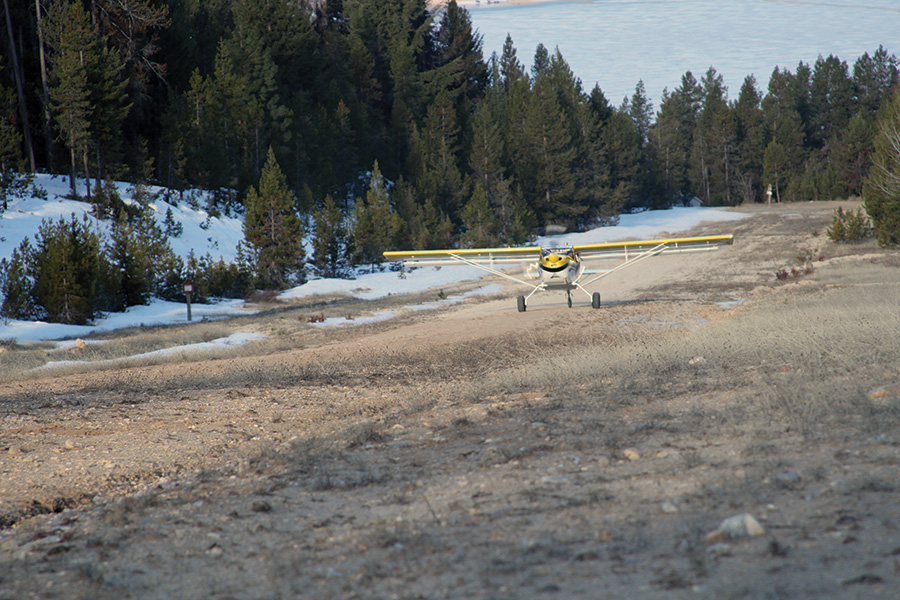
After touchdown, keep the power in to motor to the level spot at the top where you can turn around. Rolling backwards in a taildragger is not recommended.
Flying With Rocks
The second day of our abbreviated course dawned bright and early. Strike that—there was nothing “dawn” about it when Leadabrand picked me up at my downtown hotel at 0630. Our early start time was partially to help me get headed home before bumps built up later in the afternoon, partly because the morning is a great time to fly in the mountains, and partly so that we could catch breakfast at a remote ranch deep in the mountains on the Salmon River.
Most of my four decades of flying has been concentrated in the middle of North America, a vast land that is mostly flat when compared to the western part of the United States. The past few years I have increased my mountain flying quotient, and did due diligence by studying the available texts on the subject—always aware that many of those authors have met unfortunate ends in the various mountains about which they wrote. That only reinforces the need for caution when flying in rising terrain. This was my first opportunity to get some one-on-one instruction in the art of flying with rocks all around, and while I found that most of it truly is common sense—for instance, always leave yourself an out—there are things that are best taught “in the field” so to speak.
Leadabrand frequently repeated the need to customize the pattern and approach for each field—no two are ever quite alike. The pilot needs to inspect the field because conditions change with seasons, natural weathering, and the presence of animals (sometimes big ones). Approach paths need to be carefully considered. Although the rectangular pattern is a good place to start, legs are often curved, rather than straight, and views get blocked from many places. Careful consideration needs to be given to when to start descents—higher in the pattern is often better when dealing with steep, V-shaped canyons that drive you closer to the runway. Oftentimes, we’d fly the downwind across a ridge perpendicular to our course, make a steep turn into a quickly descending base leg in a narrow canyon on the other side (with the runway out of sight), then make another steep turn as the runway appeared as we exited the cross canyon.
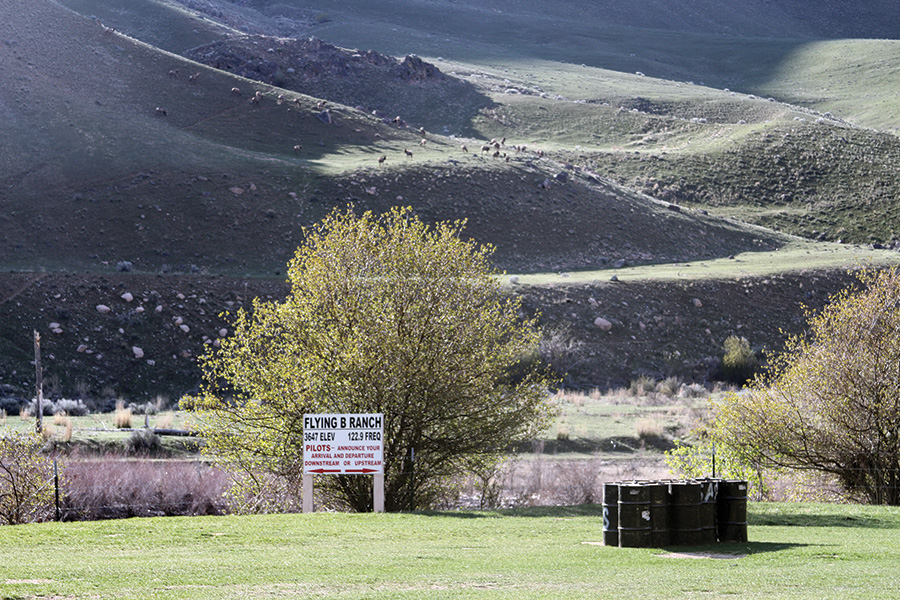
The elk on the mountain add to the atmosphere at the Flying B Ranch—a great breakfast stop in the Idaho mountains.
Before committing to a landing, the pilot needs to consider missed approach options—if there are any. Oftentimes, you can’t see escape routes from down low, and need to memorize them before you get down among ’em. Likewise, if there aren’t good abort options, the pilot needs to determine where they will hit the point of no return—after which they must land, somehow, someway. Equally important is to figure out the departure path; it would be quite embarrassing to make a perfect landing at a strip from which there is no way out.
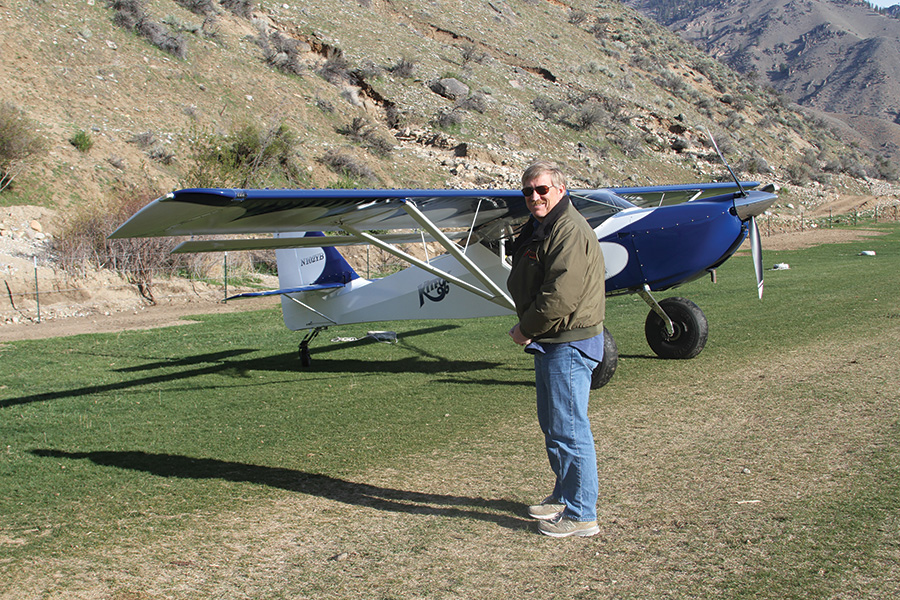
John McBean, owner of Kitfox Aircraft, can’t get enough of the Idaho backcountry, and wouldn’t miss a breakfast run to a mountain ranch.
As we flew down the river toward breakfast, we looked at many small strips along the river and discussed how we would approach them, even though we didn’t take the time to land. Leadabrand explained that there is not always only one right answer, and the give and take of discussing the how and why of various approaches was refreshing. One point he made several times was that with very few exceptions, you want to land uphill and take off downhill. If the winds are such that you are faced with a ten-knot tailwind with these rules, it is probably appropriate to ask if you should be flying at all—winds in the mountains multiply the difficulties, and reduce your options. Just as in flying everywhere, you can’t ignore the weather and get away with it for very long.
The slow-speed/high-lift capability of the Kitfox was perfectly matched to these shenanigans, and the bubble Plexiglas doors enhanced the feeling of the pilot being one with the air and the environment. It almost felt to me like I was simply flying without an airplane, and placed myself where I wanted to be as naturally as if I was walking down a set of imaginary stairs leading to the touchdown point. With approach speeds down around 50 knots and touchdown speeds lower, it was easy not to worry about staying a little high over threshold trees because we always landed uphill and ground rolls were short.
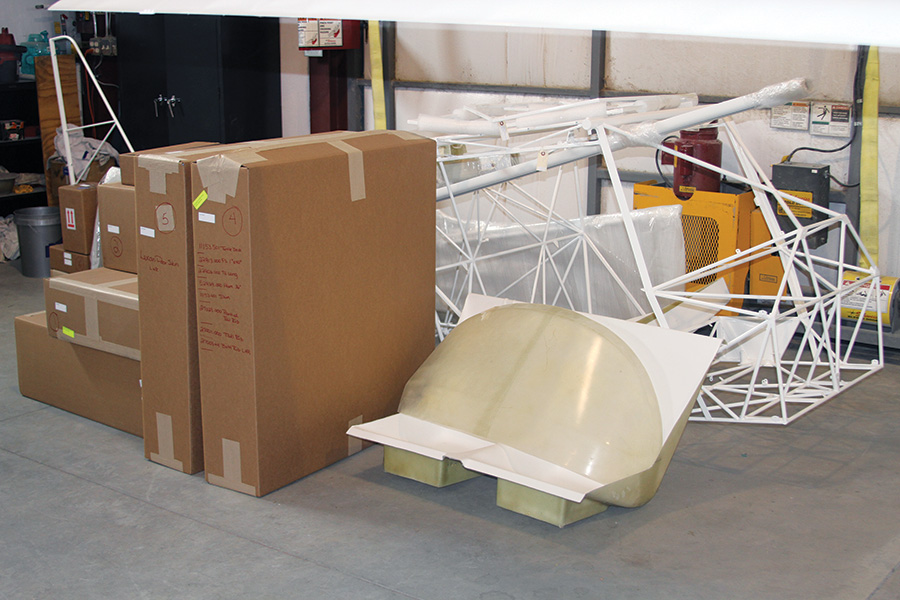
Another Kitfox, ready to head out the door—some assembly required. This is a complete airframe kit, waiting to be picked up by an eager builder.
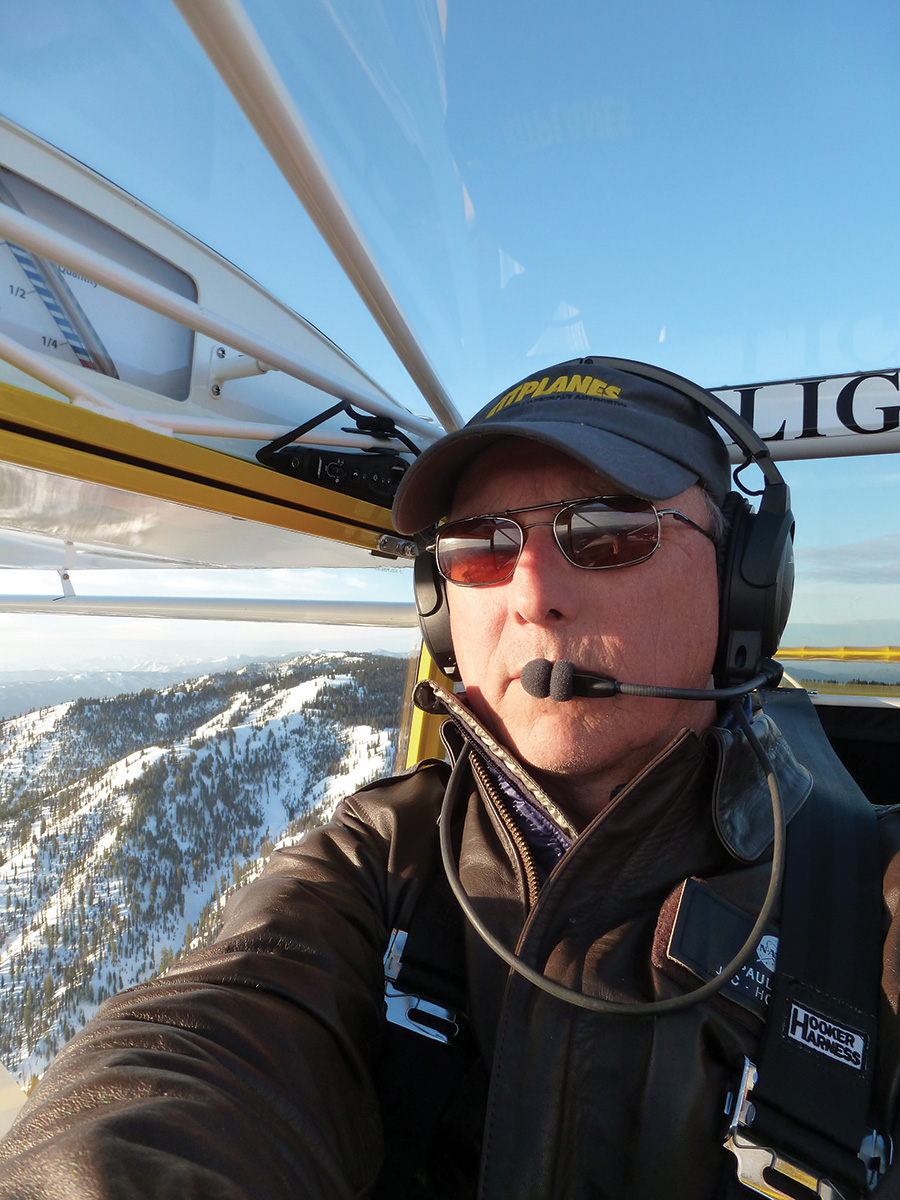
Author Paul Dye enjoying the early morning flight into the mountains. Warm clothing is recommended, even in the April thaw.
What’s Cookin’?
The breakfast stop at the Flying B Ranch was a great break in the intensity of the morning flying. The ranch, isolated deep in the mountains, is a base camp for hunters who own a share in the property. A friendly staff was on hand to prepare breakfast (with advance notice), even though we weren’t shareholders and were the only guests on the property. They were clearly getting ready for the season, and we were more than happy to help them tune their kitchen skills as we gobbled down large fluffy pancakes, eggs, thick bacon, and good coffee. All that flying really worked us up an appetite, and the pilot talk around the table was relaxing as we traded stories. We were a three-ship operation, with Leadabrand and myself in one plane, Kitfox Aircraft Owner John McBean in another with newly-licensed Brandon Petersen (factory wing builder) along for the experience. The third aircraft featured another Stick & Rudder instructor, Preston Riley (formerly a factory wing builder) giving primary instruction to the new owner of Kitfox N523BK, Bill Mearkle. Bill decided that a Kitfox would go well on his Pennsylvania farm, and that meant he’d need a license, so he came to Idaho for the package deal. This was his first foray into the backcountry with this merry band of airmen, and I never saw the smile leave his face.
Breakfast was over all too early, but we wanted to get back before the wind and bumps came up. We decided to swap seats for the return flight so I could shoot a few photographs of Leadabrand’s airplane along the way, so I strapped in with McBean, and off we went to explore a couple more fields and gather some spectacular images of airplanes, rocks, and sky. We circled overhead while Leadabrand gave another quick lesson on approaching a particularly confined strip, then climbed for altitude to cruise back across the wilderness for the long runways of the lowlands. Along the way, I sampled the formation qualities of the Kitfox, and found that aside from the typical blind spot of a high wing, the stable handling qualities made it a reasonable photo platform, as well as target.
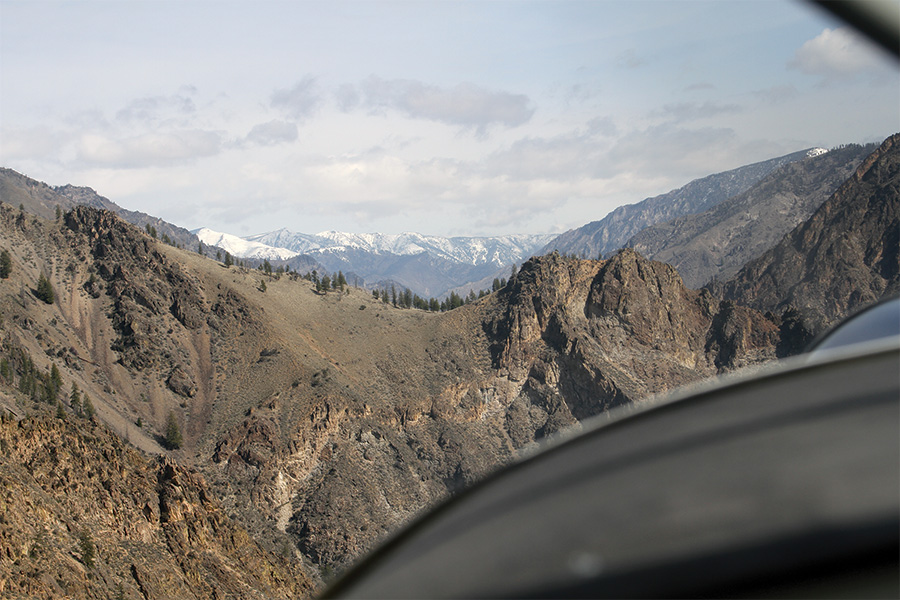
Flying the river canyons means always knowing where you are going to go next. In this case, a right turn is advisable to miss the rock.
Majestic Mountains
As we cruised along above the pine forests of the western mountains, I realized that like anything else in aviation, mountain flying is a continuous learning process. No two runways are ever going to be alike, so each one requires its own thought process. Even the same runway, visited at different times of the year, will require tweaks to the approach and touchdown points. There was still considerable snow in the highest parts of the region, and many runways were not yet usable. I asked about ski operations, and Leadabrand pointed out that, unlike the wet snow I was used to in the Midwest, their snow is very dry and powdery—providing no flotation for skis. Airplanes just tend to sink in, making operations impossible. We flew over several ranches whose strips were still covered in snow, their season dependent on the spring thaw.
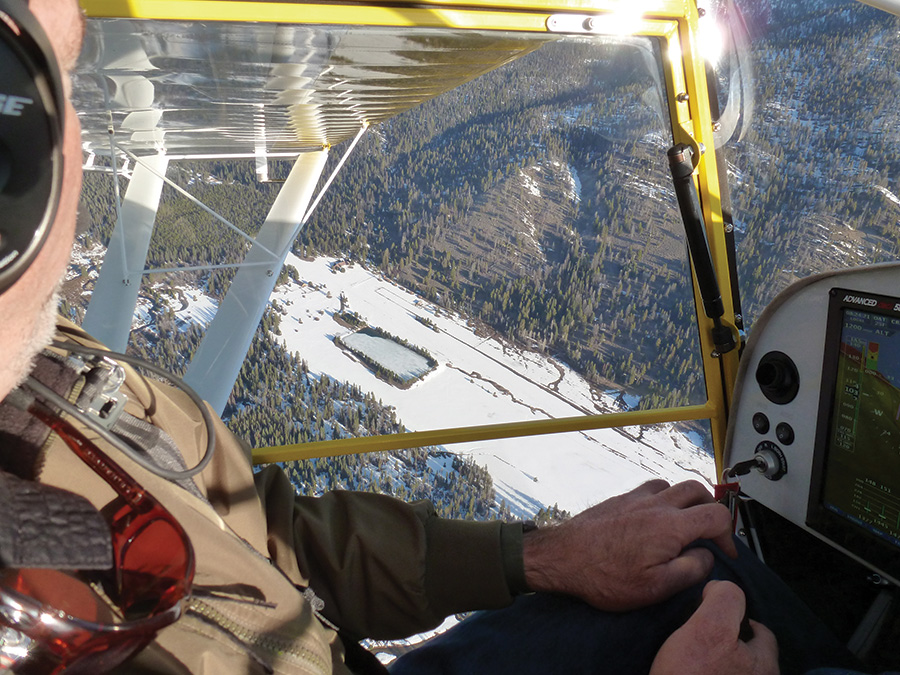
Many of the highest mountain ranch strips will be snow covered until May—then their seasons will really begin.
The breathtakingly beautiful mountains had secrets hidden around every turn—herds of elk seemed to feel no threat from our noisy machines, and reminded me of the stories of Lewis and Clark’s men subsisting primarily on the large animals they shot. There was plenty of water in the river, but it didn’t appear in flood, and Leadabrand said that the white-water rafting season was about to begin. Little camps and cabins—their only access by air—were dotted along the stream as it meandered its way through the rugged rocks of Idaho. It was easy to understand the fascination of this wilderness, and the reason pilots love to come here to relax.
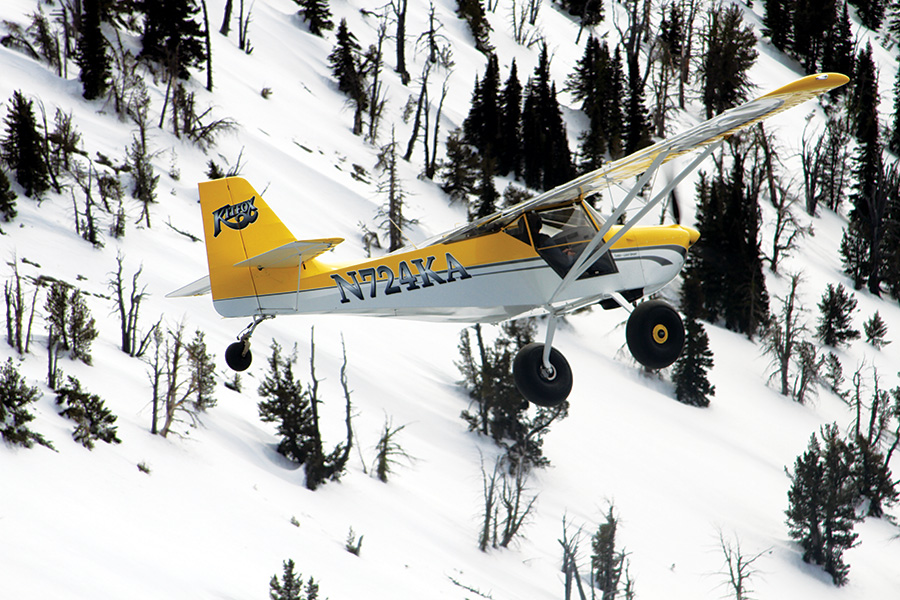
Flying in the mountains means getting comfortable with one wingtip close to the terrain. Sometimes it is the only way to get into small strips in narrow spots.
The morning was over all too early for me, and before I wanted, we were crossing the last range of mountains and entering Boise’s airspace to return to the land of radar coverage and long, paved runways. There are a lot of very neat places to fly in this world of ours—and some very interesting airplanes to take us there. Stick & Rudder Aviation offers a great program to introduce pilots to their kind of flying, in their kind of wilderness, and anyone looking for a new aviation challenge and adventure would find it intriguing and worth a look. After tasting this wilderness from the air, I can’t imagine not going back and dancing with the Kitfox on beautiful backcountry strips.
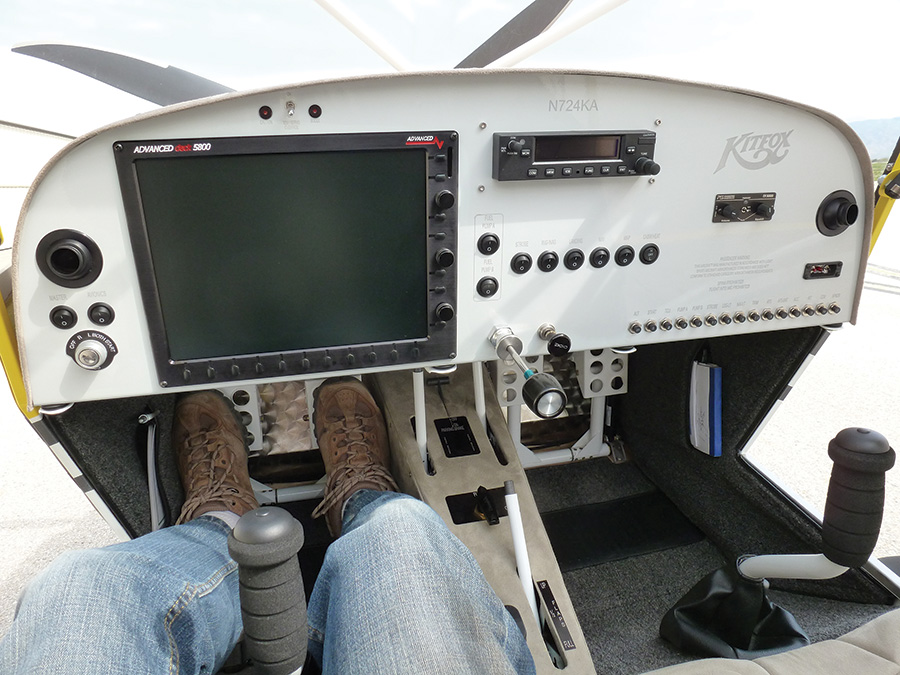
The panel of a typical factory Kitfox—all you need for day VFR flight in the backcountry. A large-screen EFIS is low maintenance, costs less than many gauges, and provides a good map.

